 || A Closer Look at The Sun
|| A Closer Look at The Sun
 The Sun giving out a large Geomagnetic Storm on 1:29 pm, EST, 13th March 2012
The Sun giving out a large Geomagnetic Storm on 1:29 pm, EST, 13th March 2012

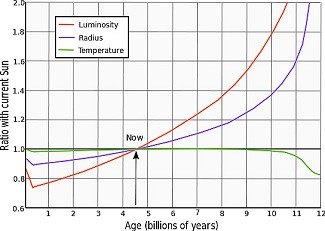 Evolution of the Sun
Evolution of the Sun
 Stonehenge is the most Architecturally Sophisticated Prehistoric Stone Circle in the world. Speculations say the Structure served as an Astronomical Calendar.
Stonehenge is the most Architecturally Sophisticated Prehistoric Stone Circle in the world. Speculations say the Structure served as an Astronomical Calendar.
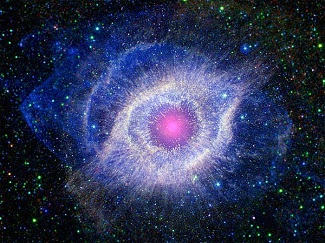 Many Scientists Expect the Sun to Die in about Seven Billion Years and become, like the Helix, a Planetary Nebula
Many Scientists Expect the Sun to Die in about Seven Billion Years and become, like the Helix, a Planetary Nebula
 Earth's Fate...?
Earth's Fate...?
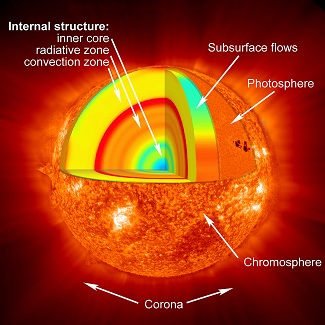 The Sun's Characteristics
The Sun's Characteristics
 Fusion Energy as it takes place Inside the Sun
Fusion Energy as it takes place Inside the Sun
 The Earth is only one small Recipient of the Sun's Electromagnetic Energy
The Earth is only one small Recipient of the Sun's Electromagnetic Energy
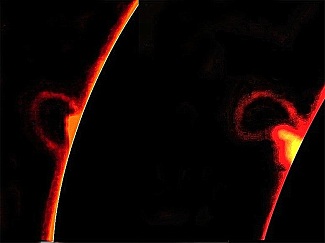 Two Successive Photos of a Solar Flare Phenomenon
Two Successive Photos of a Solar Flare Phenomenon
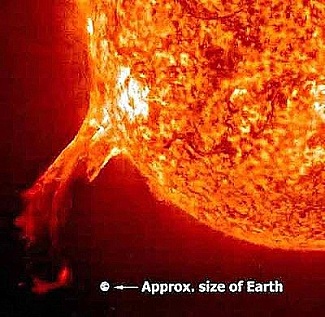
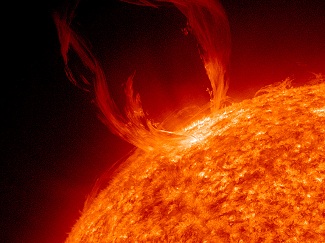 Sun Eruption (Sun Flares)
Sun Eruption (Sun Flares)
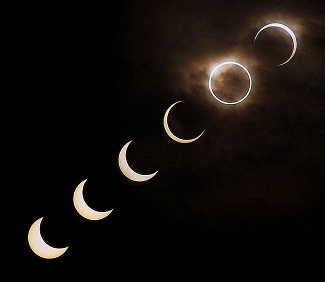 Different Stages of a Solar Eclipse
Different Stages of a Solar Eclipse
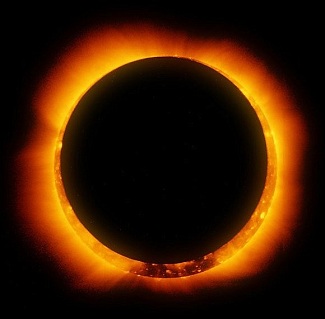 Wide Corona Solar Eclipse
Wide Corona Solar Eclipse
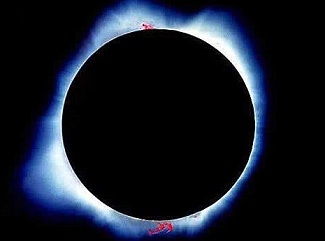 A Total Solar Eclipse as seen in Japan, 2011
A Total Solar Eclipse as seen in Japan, 2011
 Spectacular Image when a Plane passes during the Transit of Venus, June 2012
Spectacular Image when a Plane passes during the Transit of Venus, June 2012
The Sun
The Sun is the Star at the Center of the Solar System
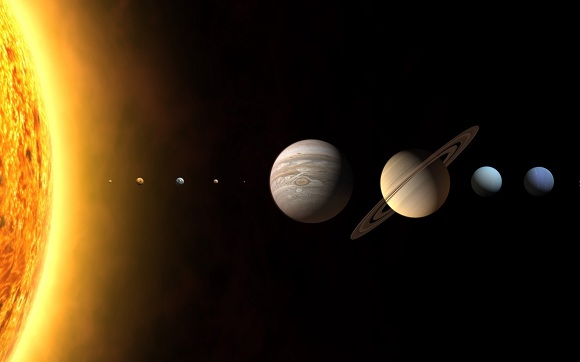
Facts about the Sun:
Mean Distance from Earth: 149,600,000 km (8 min 19 sec at Light Speed)
Mean Diameter: 1.392684×106 km
Equatorial Radius: 6.96342 ×— 10⁵ km
Equatorial Circumference: 4.379 ×10⁶ km (109 × Earth)
Average Density: 1.408×—10¹ kg/m²
Mass: 1.9891×—10³⁰ kg (333,000 × Earth)
Rotational Period (Days): 25-36 Days
The History of the Sun
The Sun formed about 4.6 Billion Years ago from the Gravitational Collapse of a Region within a large Molecular Cloud.
Most of the Matter gathered in the Center, while the rest flattened into an Orbiting disk that would become the Solar System.
The Central Mass became increasingly Hot and Dense, eventually initiating Thermo-Nuclear Fusion in its Core. It is thought that almost all other Stars form by this Process.
The Sun's Stellar Classification, based on spectral class, is G2V. In the Spectral Class Label, G2 indicates its Surface Temperature, and V indicates that the Sun, like most Stars, is a Main-Sequence Star, and thus generates its energy by Nuclear Fusion of Hydrogen Nuclei into Helium.
It is here in the Sun's Core that the Temperature (15,000,000° C) and Pressure (340 billion times Earth's Air Pressure at Sea Level) is so Intense that Nuclear Reactions take place. This Reaction causes four Protons or Hydrogen Nuclei to Fuse together to form one Alpha Particle or Helium Nucleus.
The Difference in Mass is Expelled as Energy and is carried to the Surface of the Sun, through a Process known as Convection, where it is released as Light and Heat.
Energy generated in the Sun's Core takes a Million Years to reach its Surface. Every Second 700 Million Tons of Hydrogen are converted into Helium Ashes. In the process 5 Million Tons of Pure Energy is released; therefore, as time goes on the Sun is becoming Lighter.
It was long thought that the Sun Orbited around the Earth, but it was Nicolaus Copernicus who first proposed a Sun-centered Solar System.
This Theory gained Evidence from Galileo and other early Astronomers. By the 1800s, Solar Astronomy was very advanced, with Astronomers carefully tracking Sunspots, Measuring Absorption Lines in the Spectrum of Light from the Sun, and discovering Infrared.
It wasn't until the 1930s when Astrophysicists finally Developed the Theoretical Concept of Nuclear Fusion, which Explained the Sun (and all stars) perfectly.
The Future of the Sun and Earth's Fate
Earth's Ultimate Fate is Precarious.
As a Red Giant, the Sun will have a Maximum Radius beyond the Earth's Current Orbit, (×—10¹¹ m), 250 times the Present Radius of the Sun.
However, by the Time it is an Asymptotic Giant Branch Star, the Sun will have lost roughly 30% of its Present Mass due to a Stellar Wind, so the Orbits of the Planets will move Outward.
If it were only for this, Earth would probably be Spared, but New Research suggests that Earth will be swallowed by the Sun owing to Tidal Interactions.
Even if Earth should Escape Incineration in the Sun, still all its Water will be Boiled away and most of its Atmosphere will Escape into Space.
Even during its Current Life in the Main Sequence, the Sun is gradually becoming more Luminous (about 10% every 1 Billion years), and its Surface Temperature is Slowly Rising.
The Sun used to be Fainter in the past, which is possibly the reason Life on Earth has only Existed for about 1 Billion Years on land.
If Nature is left to its own Devices, about 7.59 Billion Years from now Earth will be Dragged from its Orbit by an Engorged Red Sun and Spiral to a Rapid Vaporous Death due to the Increase in Solar Temperatures and the Surface of the Earth will likely become too Hot for Liquid Water to exist, ending all Terrestrial Life......

Characteristics of the Sun
The Sun is a G-type Main-Sequence Star comprising about 99.86% of the Total Mass of the Solar System.
It is a Near-Perfect Sphere, with an Oblateness Estimated at about 9 millionth, which means that its Polar Diameter differs from its Equatorial Diameter by only 10 km.
As the Sun Consists of a Plasma and is not Solid, it rotates faster at its Equator than at its Poles. This behavior is known as Differential Rotation, and is caused by Convection in the Sun and the movement of Mass, due to steep Temperature gradients from the Core Outwards. The Period of this Actual Rotation is approximately 25.6 Days at the Equator and 33.5 Days at the Poles.
The Sun is a Population I, or Heavy Element-rich Star. The Formation of the Sun may have been triggered by Shockwaves from one or more nearby Supernovae. This is suggested by a high Abundance of Heavy Elements in the Solar System, such as Gold and Uranium, relative to the Abundances of these Elements in so-called Population II (Heavy Element-poor) Stars.
The Sun does not have a Definite Boundary as Rocky Planets do, and in its Outer Parts the Density of its Gases drops Exponentially with increasing Distance from its Center.
Nevertheless, it has a Well-Defined Interior Structure, described below. The Sun's Radius is measured from its Center to the Edge of the Photosphere. This is simply the Layer above which the Gases are too Cool or too Thin to Radiate a Significant amount of Light, and is therefore the surface most readily visible to the Naked Eye.
The Solar Interior is not directly Observable, and the Sun itself is Opaque to Electromagnetic Radiation. However, just as Seismology uses Waves generated by Earthquakes to reveal the Interior Structure of the Earth, the discipline of Helio-Seismology makes use of Pressure Waves (Infrasound) traversing the Sun's Interior to Measure and Visualize the Star's Inner Structure. Computer Modeling of the Sun is also used as a Theoretical tool to Investigate its Deeper Layers.
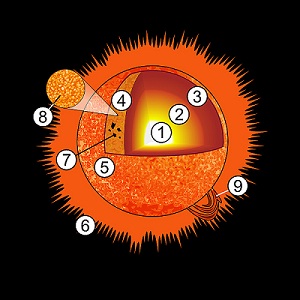
1. Core | 2. Radiative zone | 3. Convective zone | 4. Photosphere | 5. Chromosphere | 6. Corona | 7. Sunspot | 8. Granules | 9. Prominence
Solar Flares and the Effects on Earth
A Solar Flare is a sudden Brightening Observed over the Sun's Surface or the Solar Limb, which is Interpreted as a Large Energy Release of up to 6 × 10²⁵ Joules of Energy (About a Sixth of the Total Energy output of the Sun each Second).
They are Mainly Followed by a Colossal Coronal Mass Ejection also known as a CME.
The Flare Ejects Clouds of Electrons, Ions, and Atoms through the Corona of the Sun into Space. These Clouds typically reach Earth a Day or two after the Event.
Solar Flares affect all Layers of the Solar Atmosphere (Photosphere, Chromosphere, and Corona), when the Medium Plasma is Heated to Tens of Millions of Kelvins and Electrons, Protons, and Heavier Ions are Accelerated to near the Speed of Light.
They produce Radiation across the Electromagnetic Spectrum at all Wavelengths. Flares occur in Active Regions around Sunspots, where Intense Magnetic Fields penetrate the Photosphere to link the Corona to the Solar Interior. Flares are Powered by the sudden (Timescales of Minutes to tens of Minutes) release of Magnetic Energy stored in the Corona.
Solar Flares also Influence our Lives on Earth. Scientists know Solar Flares Affect and Charge the Electromagnetic Fields of the Earth. We live in as well as link to the Electromagnetic Field of the Earth. When this Field is Stable we tend to be more stable. When Solar Flares Intensify, our Emotional Bodies become more Unstable and get thrown out of Balance.
Influences of Solar Flares:
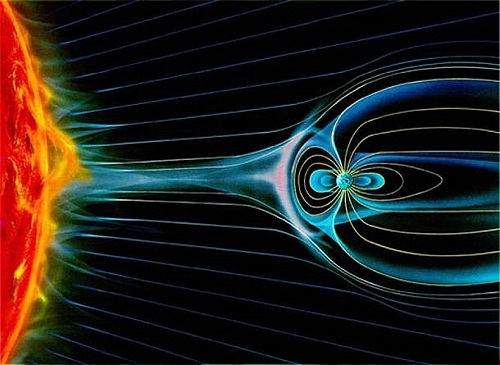
Solar Activity Directly Affects Our:
Central Nervous Systems
Stomach Lining
All Brain Activity Including Balance
All Human and Animal Behavior
All Psycho Physiological (Mental/ Emotional/Physical) Response
Solar Eclipse
As seen from the Earth, a Solar Eclipse occurs when the Moon passes between the Sun and Earth, and the Moon Fully or Partially blocks the Sun.
This can happen only at New Moon, when the Sun and the Moon are in Conjunction as seen from Earth.
In a Total Eclipse, the Disk of the Sun is Fully Obscured by the Moon. In Partial and Annular Eclipses only Part of the Sun is Obscured.
If the Moon were in a Circular Orbit Close enough to the Earth and in the Same Orbital Plane, there would be Total Solar Eclipses every Single Month.
However, the Moon's Orbit is Inclined or Tilted at more than 5 Degrees to Earth's Orbit around the Sun so its Shadow at New Moon usually misses Earth.
Earth's Orbit is called the Ecliptic Plane as the Moon's Orbit must Cross this Plane in order for an Eclipse (both Solar as well as Lunar) to Occur. In Addition, the Moon's Actual Orbit is Elliptical, often taking it far enough away from Earth that its Apparent Size is not large enough to block the Sun Totally.
The Orbital Planes Cross each Year at a Line of Nodes Resulting in at Least Two, and up to Five, Solar Eclipses Occurring each Year; No more than Two of which can be Total Eclipses. Total Solar Eclipses are nevertheless Rare at Any Particular Location because Totality Exists only along a Narrow Path on Earth's Surface traced by the Moon's Shadow or Umbra.
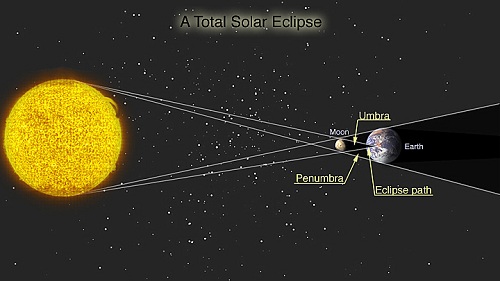
Solar Transits:
Transits happen when a Planet crosses between Earth and the Sun. Only Mercury and Venus, which are closer to the Sun than our Planet, can undergo this Unusual Alignment. With its relatively Tight Orbit, Mercury circles the Sun Fast enough that we see the Innermost Planet transit every 13 to 14 Years. But Transits of Venus are exceedingly Rare, due to that World's Tilted Orbit: After the 2012 Venus Transit, we won't see another until December 10, 2117...
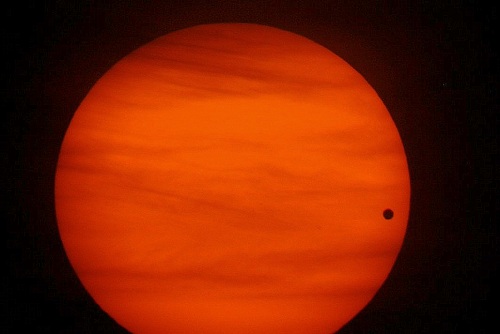
Venus Transit on June 6, 2012
